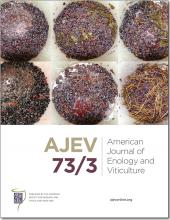Abstract
Recent increases in average air temperatures and heat wave intensity can present challenges in maintaining grape productivity and quality. As a result, growers are exploring approaches to protect berries from excessive temperatures, however, they can be costly and time-consuming to experimentally evaluate, and results may not be generalizable. In this work, we developed and evaluated a new 3-D model that can predict metrics related to berry temperature and light interception in response to varying vineyard architecture, topography, and shade cloth density. The resulting modeling tool was applied to better understand and evaluate a range of potential vineyard design and management practices for mitigation of elevated berry temperatures in vertically trained grapevines. Model validation showed close agreement between predicted and measured temperature dynamics, which responded appropriately to the application of shade cloth. In a simulation experiment, row spacing, row orientation, slope grade and aspect, and shade cloth density were varied to evaluate their effect on berry and canopy light interception, berry temperature spikes, and integrated berry heat accumulation. On flat terrain, a northeast-southwest row orientation provided the best compromise of berry light and temperature balance between opposing vine faces while avoiding excessive berry temperatures, while north-south rows provided good daily symmetry but had risk of high afternoon berry temperatures. The efficacy of shade cloth in mitigating excessive temperatures depended strongly on all variables considered. Slopes with southern or western exposure increased the imbalance in and risk of high berry temperatures, which in some cases could not be well-managed by shade cloth. Overall, the modeling tool appears capable of providing quantitative guidance for vineyard design and management where excessive berry temperatures are of concern.
- Received November 2021.
- Revision received February 2022.
- Accepted February 2022.
- Published online August 2022
- Copyright © 2022 by the American Society for Enology and Viticulture. All rights reserved.
Sign in for ASEV members
ASEV Members, please sign in at ASEV to access the journal online.
Sign in for Institutional and Non-member Subscribers
Log in using your username and password
Pay Per Article - You may access this article (from the computer you are currently using) for 2 day for US$10.00
Regain Access - You can regain access to a recent Pay per Article purchase if your access period has not yet expired.










